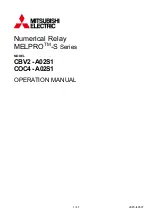
145
6
F
2
S
0
8
3
4
2.8 Fault
Locator
2.8.1 Application
GRZ100 provides the following two type fault location methods:
-
Fault location using the only local end data for two terminal application
-
Fault location using the local and remote end data (only for integral communication and three
terminal application)
The fault locator using the only local end data is applied when the scheme switch “CO.LINK” is
set to “Ext”. When the scheme switch “CO.LINK” set to “Int”, both types of fault locator are
applied in three-terminal application. Table 2.8.1.1 shows type of fault locator in integral
communication and three-terminal application.
Table 2.8.1.1 Type of Fault Location
Communication system
Fault location calculated by
Ring-topology
Relay A
CH1
CH2
Relay B
CH1
CH2
Relay C
CH2
CH1
Relay A: Local and remote ends data
Relay B: Local and remote ends data
Relay C: Local and remote ends data
Chain-topology
Relay A
CH1
CH2
Relay B
CH1
CH2
Relay C
CH2
CH1
Relay A: Local end data
Relay B: Local and remote ends data
Relay C: Local end data
The measurement result is expressed as a percentage (%) of the line length and the distance (km)
and is displayed on the LCD on the relay front panel. In three-terminal application, however, the
measurement result is expressed as a fault section instead of a percentage. It is also output to a
local PC or RSM (relay setting and monitoring) system.
To measure the distance to fault, the fault locator requires minimum 3 cycles as a fault duration
time.
In distance to fault calculations, the change in the current before and after the fault has occurred is
used as a reference current, alleviating influences of the load current and arc voltage. As a result,
the location error in fault location using only local end data is a maximum of
±
2.5 km for faults at
a distance of up to 100 km, and a maximum of
±
2.5% for faults at a distance between 100 km and
399.9 km. The location error in fault location using local and remote ends data is a maximum of
±
2.0 km for faults at a distance of up to 100 km, and a maximum of
±
2.0% for faults at a distance
between 100 km and 399.9 km at the positive differential current more than In (rated current). If a
fault current is more than 25
×
In, the location error is larger than above. (See Appendix K.)
Note: If abnormal settings far from actual transmission line impedance, e.g. resistance
value so larger than reactance value, etc., are done, the location error will be larger.
The fault locator cannot correctly measure the distance to fault during a power swing.
Fault location is enabled or disabled by setting "Fault locator" to "ON" or "OFF" on the "Fault
record" screen in the "Record" sub-menu.
www
. ElectricalPartManuals
. com
Summary of Contents for GRZ100-211B
Page 323: ... 322 6 F 2 S 0 8 3 4 w w w E l e c t r i c a l P a r t M a n u a l s c o m ...
Page 343: ... 342 6 F 2 S 0 8 3 4 w w w E l e c t r i c a l P a r t M a n u a l s c o m ...
Page 383: ... 382 6 F 2 S 0 8 3 4 w w w E l e c t r i c a l P a r t M a n u a l s c o m ...
Page 395: ... 394 6 F 2 S 0 8 3 4 w w w E l e c t r i c a l P a r t M a n u a l s c o m ...
Page 411: ... 410 6 F 2 S 0 8 3 4 w w w E l e c t r i c a l P a r t M a n u a l s c o m ...
Page 423: ... 422 6 F 2 S 0 8 3 4 w w w E l e c t r i c a l P a r t M a n u a l s c o m ...
Page 443: ... 442 6 F 2 S 0 8 3 4 w w w E l e c t r i c a l P a r t M a n u a l s c o m ...
Page 451: ... 450 6 F 2 S 0 8 3 4 w w w E l e c t r i c a l P a r t M a n u a l s c o m ...
Page 459: ... 458 6 F 2 S 0 8 3 4 w w w E l e c t r i c a l P a r t M a n u a l s c o m ...
Page 463: ...w w w E l e c t r i c a l P a r t M a n u a l s c o m ...
















































